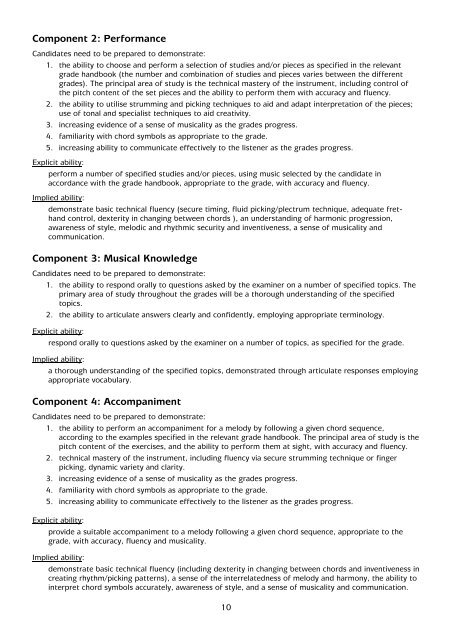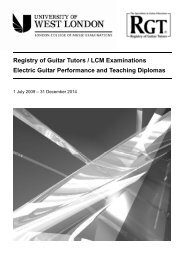LCM Exams / RGT: Acoustic Guitar Grades Syllabus - Registry of ...
LCM Exams / RGT: Acoustic Guitar Grades Syllabus - Registry of ...
LCM Exams / RGT: Acoustic Guitar Grades Syllabus - Registry of ...
You also want an ePaper? Increase the reach of your titles
YUMPU automatically turns print PDFs into web optimized ePapers that Google loves.
Component 2: Performance<br />
Candidates need to be prepared to demonstrate:<br />
1. the ability to choose and perform a selection <strong>of</strong> studies and/or pieces as specified in the relevant<br />
grade handbook (the number and combination <strong>of</strong> studies and pieces varies between the different<br />
grades). The principal area <strong>of</strong> study is the technical mastery <strong>of</strong> the instrument, including control <strong>of</strong><br />
the pitch content <strong>of</strong> the set pieces and the ability to perform them with accuracy and fluency.<br />
2. the ability to utilise strumming and picking techniques to aid and adapt interpretation <strong>of</strong> the pieces;<br />
use <strong>of</strong> tonal and specialist techniques to aid creativity.<br />
3. increasing evidence <strong>of</strong> a sense <strong>of</strong> musicality as the grades progress.<br />
4. familiarity with chord symbols as appropriate to the grade.<br />
5. increasing ability to communicate effectively to the listener as the grades progress.<br />
Explicit ability:<br />
perform a number <strong>of</strong> specified studies and/or pieces, using music selected by the candidate in<br />
accordance with the grade handbook, appropriate to the grade, with accuracy and fluency.<br />
Implied ability:<br />
demonstrate basic technical fluency (secure timing, fluid picking/plectrum technique, adequate frethand<br />
control, dexterity in changing between chords ), an understanding <strong>of</strong> harmonic progression,<br />
awareness <strong>of</strong> style, melodic and rhythmic security and inventiveness, a sense <strong>of</strong> musicality and<br />
communication.<br />
Component 3: Musical Knowledge<br />
Candidates need to be prepared to demonstrate:<br />
1. the ability to respond orally to questions asked by the examiner on a number <strong>of</strong> specified topics. The<br />
primary area <strong>of</strong> study throughout the grades will be a thorough understanding <strong>of</strong> the specified<br />
topics.<br />
2. the ability to articulate answers clearly and confidently, employing appropriate terminology.<br />
Explicit ability:<br />
respond orally to questions asked by the examiner on a number <strong>of</strong> topics, as specified for the grade.<br />
Implied ability:<br />
a thorough understanding <strong>of</strong> the specified topics, demonstrated through articulate responses employing<br />
appropriate vocabulary.<br />
Component 4: Accompaniment<br />
Candidates need to be prepared to demonstrate:<br />
1. the ability to perform an accompaniment for a melody by following a given chord sequence,<br />
according to the examples specified in the relevant grade handbook. The principal area <strong>of</strong> study is the<br />
pitch content <strong>of</strong> the exercises, and the ability to perform them at sight, with accuracy and fluency.<br />
2. technical mastery <strong>of</strong> the instrument, including fluency via secure strumming technique or finger<br />
picking, dynamic variety and clarity.<br />
3. increasing evidence <strong>of</strong> a sense <strong>of</strong> musicality as the grades progress.<br />
4. familiarity with chord symbols as appropriate to the grade.<br />
5. increasing ability to communicate effectively to the listener as the grades progress.<br />
Explicit ability:<br />
provide a suitable accompaniment to a melody following a given chord sequence, appropriate to the<br />
grade, with accuracy, fluency and musicality.<br />
Implied ability:<br />
demonstrate basic technical fluency (including dexterity in changing between chords and inventiveness in<br />
creating rhythm/picking patterns), a sense <strong>of</strong> the interrelatedness <strong>of</strong> melody and harmony, the ability to<br />
interpret chord symbols accurately, awareness <strong>of</strong> style, and a sense <strong>of</strong> musicality and communication.<br />
10



